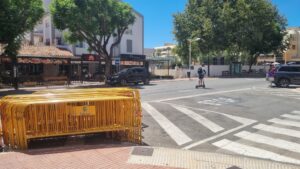ELECTION 28M: How to vote in the municipal elections
This Sunday 28th May, more than 15,000 people in Xàbia are qualified to head to the polling station and vote for their preferred party to manage the town for the next four years.

Friday 26th May 2023
Mike Smith
This Sunday, the municipal elections will be held across Spain. This will be the first time that UK citizens have not been able to vote by right as EU citizens, although a post-Brexit bilateral agreement between the UK and Spain meant that UK citizens legally resident in Spain could continue to do so and will have been required to register their desire to vote at the beginning of this year.
Each of the six political parties seeking your vote in Xàbia – PSOE, PP, Ciudadanos por Jávea, Compromís, Podemos and Vox – will have already presented their candidate lists, 21 people for the 21 positions available on the local council. Over the past week or so, if you have been registered to vote, you will most probably have received plenty of manifesto brochures as well as a print-out of those lists and some envelopes.
In Spain, you vote for the party rather than the individual, even though the campaign rallies have often highlighted the person at the top of their list, the candidate who would assume the position of mayor if their party wins the most votes in the election.
How do I vote?
On election day – Sunday 28th May – you take your voting slip and valid ID to the polling station that has been allocated to you; this will be clearly printed on your voting slip which you will have received through the post.
Valid ID includes the DNI (Spanish ID Card), a passport with photograph, a driver’s licence with photograph, a residency card in the case of EU citizens, or an ID card in the case of foreign nationals of countries with which Spain has signed a reciprocity treaty for the recognition of the right to vote in local elections. These must be originals and not photocopies. They can be Spanish documentation or that issued by the country of origin of the holder so long as they include a photograph.
The polling stations open to the general public at 9.00am and close at 8.00pm, although if there are people still inside the building who have not yet cast their vote, they will be allowed to so after that time.
Some people will have already made their decision and placed their choice in the official envelope before entering the polling station; this saves some time. If not, you simply enter an available polling booth, pull the curtain closed behind you, choose one of the candidate lists and place it in an official envelope. For municipal elections, you will need to select one of the white candidate lists. The other lists are for the autonomous elections and are coloured sepia; if you are British, ignore these as UK citizens with the right to vote can only do so in the municipal elections. Leave the booth and approach the table with the ballot box. Leave the booth and approach the table with the ballot box.
Your identification will be checked against the list of registered voters and, once confirmed, the sealed envelope will be handed to the responsible person, normally the president of the polling station, who will place it in the appropriate ballot box, saying aloud the voter’s name and the confirmation “vota”.
And that’s it. You’ve played your part in determining the fate of the next four years of our town.
Who wins?
The proportional representation system assures that seats on the council are distributed according to the popularity of the party with the electorate.
The number of seats is allocated uses the D’Hondt Method, also known as the highest average method, with aims to distribute the seats as evenly as possible. The party which gains the most votes is given the first seat, essentially the position of mayor, and then their total number of votes is divided by two (one seat plus 1). If that new number is still the highest number of votes out of all the parties, then that party wins another seat and their total is further divided, this time by 3 (two seats plus 1). But if another party is higher, they win the next seat and their total is divided by two (1 seat plus 1). The sequence begins again; we determine which party now has the highest number of votes and they get the next seat and their total is divided according to their previous allocation.
In 2019, PSOE attracted just over 45% of the vote which equated to 11 seats on the local council. Thus, José Chulvi won a third term in office and his socialist party gained a majority of one over all the other parties. (PP won 5 seats, Ciudadanos por Javea and Compromís 2 seats each and Cs a single seat. Podemos attracted less than 5% of the vote and consequently didn’t get enough support to win a seat on the council.)
For those who want to follow the results as they come in, the town hall will be open on Sunday evening where they will be relayed in real time onto a big screen in the council chambers.





